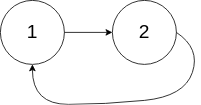这篇文章主要介绍“C++如何实现单链表中的环”,在日常操作中,相信很多人在C++如何实现单链表中的环问题上存在疑惑,小编查阅了各式资料,整理出简单好用的操作方法,希望对大家解答”C++如何实现单链表中的环”的疑惑有所帮助!接下来,请跟着小编一起来学习吧!
Example 1:
Input: head = [3,2,0,-4], pos = 1
Output: tail connects to node index 1
Explanation: There is a cycle in the linked list, where tail connects to the second node.

Example 2:
Input: head = [1,2], pos = 0
Output: tail connects to node index 0
Explanation: There is a cycle in the linked list, where tail connects to the first node.

Example 3:
Input: head = [1], pos = -1
Output: no cycle
Explanation: There is no cycle in the linked list.

Follow up:
Can you solve it without using extra space?
这个求单链表中的环的起始点是之前那个判断单链表中是否有环的延伸,可参之前那道 Linked List Cycle。这里还是要设快慢指针,不过这次要记录两个指针相遇的位置,当两个指针相遇了后,让其中一个指针从链表头开始,一步两步,一步一步似爪牙,似魔鬼的步伐。。。哈哈,打住打住。。。此时再相遇的位置就是链表中环的起始位置,为啥是这样呢,这里直接贴上热心网友「飞鸟想飞」的解释哈,因为快指针每次走2,慢指针每次走1,快指针走的距离是慢指针的两倍。而快指针又比慢指针多走了一圈。所以 head 到环的起点+环的起点到他们相遇的点的距离 与 环一圈的距离相等。现在重新开始,head 运行到环起点 和 相遇点到环起点 的距离也是相等的,相当于他们同时减掉了 环的起点到他们相遇的点的距离。代码如下:
class Solution {
public:
ListNode *detectCycle(ListNode *head) {
ListNode *slow = head, *fast = head;
while (fast && fast->next) {
slow = slow->next;
fast = fast->next->next;
if (slow == fast) break;
}
if (!fast || !fast->next) return NULL;
slow = head;
while (slow != fast) {
slow = slow->next;
fast = fast->next;
}
return fast;
}
};到此,关于“C++如何实现单链表中的环”的学习就结束了,希望能够解决大家的疑惑。理论与实践的搭配能更好的帮助大家学习,快去试试吧!若想继续学习更多相关知识,请继续关注亿速云网站,小编会继续努力为大家带来更多实用的文章!
亿速云「云服务器」,即开即用、新一代英特尔至强铂金CPU、三副本存储NVMe SSD云盘,价格低至29元/月。点击查看>>
免责声明:本站发布的内容(图片、视频和文字)以原创、转载和分享为主,文章观点不代表本网站立场,如果涉及侵权请联系站长邮箱:is@yisu.com进行举报,并提供相关证据,一经查实,将立刻删除涉嫌侵权内容。
原文链接:https://my.oschina.net/u/3335309/blog/4589375